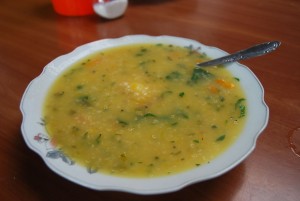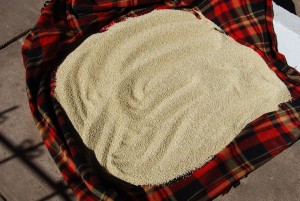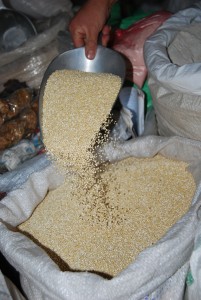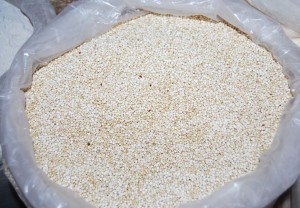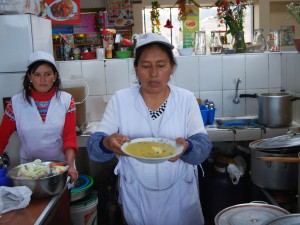Much More than a Seed: Quinoa in Cuzco

Though it has various spellings–quinoa, quinua, or kinwa– this seed is a grain that we in Cuzco have inherited from our ancestors which is claiming ever greater value in today’s world. Not only do we make from it a wonderful variety of food, we also find other uses and meanings.
“Have a delicious quinoa soup, caserito” shouted out a warm voice in the food stands of Cuzco’s San Pedro Market. I was hungry and a lot of voices offering a whole range of dishes, but that voice and that quinoa soup piqued my appetite.
While lifting spoonful after spoonful to my mouth, I began thinking about how important quinoa is in rural Cuzco and in the city for us and our nourishment.
While growing the quinoa plant shows all the different colors of the rainbow that, as a flag, has become the symbol of Cuzco. No other plant shows such variety of colors.
But it is more. Cultivation of quinoa has been passed down from generation to generation in rural Cuzco. There, people rely on ayni, the building of ties through helping each other, in the sewing and harvest of all Andean products and ayni is a value we still have in the city, though not as strongly as in rural Peru. Still it is one of the main moral codes of Tawantinsuyo, the Inca Empire that the older people talk about.

In December people sew quinoa, since that is the month when rain falls and waters the earth. It helps the plants grow and develop. Quinoa is harvested when the plant has dried up, such as in the months of April and May when the rains have ended and the dry season begins. Quinoa in its growth marks the passing of time in Cuzco.
To harvest quinoa, people wait until the plants are completely dry. They then cut them at their base and then, with large flat stones, rub the seed heads to release all the nourishing little seeds each plant holds. Once stored these seeds, or grain, will feed a family throughout the rest of the year.
A quinoa plant produces so many little seeds that they become a symbol of abundance and wealth, not unlike what the mustard seed is in European traditions. Sometimes, when people want to improve their luck, or get more money, they may buy a small pot with lots of little quinoa seeds overflowing it like a prayer in hope of getting what they want.
In olden days, before there were chemical detergents widely available, people would wash their clothes in the bitter foam that came off quinoa seeds. To eat them you had to first wash them in lots of water, because for protection the quinoa seeds have a chemical called saponin that is a natural detergent, as its name suggests. People still say that clothes washed in quinoa foam come out softer than clothes washed in detergent.
After the harvest, people keep their quinoa in big, woven bags called costales. Or they will also wrap it in woven cloths called lliqllasto then keep it in their storage rooms or other dry places in order to eat it little by little throughout the year.
The quinoa must be stored in dry places because if it is placed in damp places the seeds will sprout and throw out roots. They say that sprouted quinoa is not good for you to eat.
When first harvested, most quinoa around Cuzco has a yellowish tint (though there are other colors of quinoa found.) When washed it takes on a light cream color, just like the uniform of an important Peruvian soccer team, the Universitario de Deportes.
Quinoa is increasingly claiming greater value around the world. It can be used in a great range of dishes. It is only limited by the creativity of chefs and cooks. Yet it is also a great food with very high nutritional value to keep us healthy and strong.
As I lift my last spoonful of quinoa soup to my mouth I am struck by how meaningful quinoa is and how deeply it fits into our traditions. It is about as Peruvian and Cuzqueño as you can get.

